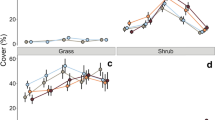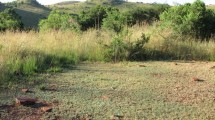Abstract
We studied how ungulates and a large variation in site conditions influenced grassland nitrogen (N) dynamics in Yellowstone National Park. In contrast to most grassland N studies that have examined one or two soil N processes, we investigated four rates, net N mineralization, nitrification, denitrification, and inorganic N leaching, at seven paired sites inside and outside long-term (33+ year) exclosures. Our focus was how N fluxes were related to one another among highly variable grasslands and how grazers influenced those relationships. In addition, we examined variation in soil δ15N among grasslands and the relationships between soil 15N abundance and N processes. Previously, ungulates were reported to facilitate net N mineralization across variable Yellowstone grasslands and denitrification at mesic sites. In this study, we found that herbivores also promoted nitrification among diverse grasslands. Furthermore, net N mineralization, nitrification, and denitrification (kg N ha–1 year–1, each variable) were postively and linearly related to one another among all grasslands (grazed and fenced), and grazers reduced the nitrification/net N mineralization and denitrification/net N mineralization ratios, indicating that ungulates inhibited the proportion of available NH4 + that was nitrified and denitrified. There was no relationship between net N mineralization or nitrification with leaching (indexed by inorganic N adsorbed to resin buried at the bottom of rooting zones) and leaching was unaffected by grazers. Soil δ15N was positively and linearly related to in situ net N mineralization and nitrification in ungrazed grasslands; however, there was no relationship between isotopic composition of N and those rates among grazed grasslands. The results suggested that grazers simultaneously increased N availability (stimulated net N mineralization and nitrification per unit area) and N conservation (reduced N loss from the soil per unit net N mineralization) in Yellowstone grasslands. Grazers promoted N retention by stimulating microbial productivity, probably caused by herbivores promoting labile soil C. Process-level evidence for N retention by grazers was supported by soil δ15N data. Grazed grassland with high rates of N cycling had substantially lower soil δ15N relative to values expected for ungrazed grassland with comparable net N mineralization and nitrification rates. These soil 15N results suggest that ungulates inhibited N loss at those sites. Such documented evidence for consumer control of N availability to plants, microbial productivity, and N retention in Yellowstone Park is further testimony for the widespread regulation of grassland processes by large herbivores.
Similar content being viewed by others
Author information
Authors and Affiliations
Additional information
Received: 5 May 1999 / Accepted: 1 November 1999
Rights and permissions
About this article
Cite this article
Frank, D., Groffman, P., Evans, R. et al. Ungulate stimulation of nitrogen cycling and retention in Yellowstone Park grasslands. Oecologia 123, 116–121 (2000). https://doi.org/10.1007/s004420050996
Issue Date:
DOI: https://doi.org/10.1007/s004420050996




